ARCHIVED – Canada’s Adoption of Renewable Power Sources – Energy Market Analysis
This page has been archived on the Web
Information identified as archived is provided for reference, research or recordkeeping purposes. It is not subject to the Government of Canada Web Standards and has not been altered or updated since it was archived. Please contact us to request a format other than those available.
Wind
Wind power is captured by turbine blades that spin a shaft connected to a generator. The blades of wind turbines work on the same principle as airplane propellers. In the case of wind turbines, the wind passes over the blades and the rotor turns because the pressure difference between the upper and lower surfaces creates lift.
Modern wind turbines are increasingly cost-effective, reliable, and powerful. Turbine nameplate capacity, height, and rotor diameter have all increased significantly. Wind turbines can now generate electricity for 20-25 years, and can run for as many as 120 000 hours over their lifetime.
Canadian Adoption
In 2015, Canada produced 4.4% of its electricity from wind, and every Canadian province and territory (except Nunavut) generated some power from wind. Canada has ample wind resources because of its diverse geography, but its cold climate poses challenges related to working conditions, road access in winter, and turbine technology impacts.
In 2015, Canada had over 11 000 MW of total installed wind capacity and was the 7th largest wind energy producer in the world (See Figure 10). Between 2010 and 2015, Canada’s installed wind capacity grew by 24% per year.
This capacity could grow further due to provincial and federal initiatives. For example, Alberta’s government unveiled a new climate strategy in November 2015 that pledges to generate 30% of Alberta’s electricity from renewable sources such as wind, hydro and solar by 2030.
Table 4 – Wind Electricity in Canada: Key Statistics
| Key Statistics (2015) | Wind |
|---|---|
| Installed capacity | 11 072 MW |
| Share of Canada’s capacity | 7.7% |
| Share of Canada's generation | 4.4% |
| Electricity generated | 28 561 GW.h |
| Generation growth from 2005 to 2015 | 1 866% |
Source: Canada’s Energy Future 2016: Update – Energy Supply and Demand Projections to 2040
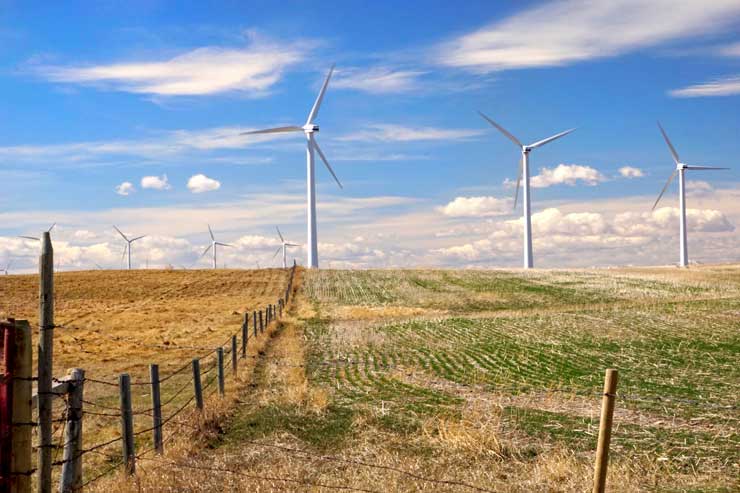
Figure 9 – Wind Capacity in Canada
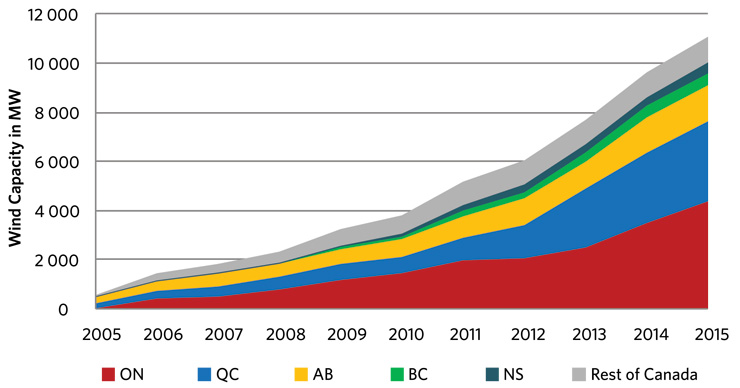
Source: Canada’s Energy Future 2016: Update – Energy Supply and Demand Projections to 2040
Description:
The stacked area chart shows wind capacity in five Canadian leading provinces and the rest of Canada between 2005 and 2015. The five provinces with the largest wind capacity are Ontario, Quebec, Alberta, B.C. and Nova Scotia. Wind capacity grew strongly between 2005 and 2010 and even more sharply between 2010 and 2015.
Figure 10 – Map of Wind Power Plants in Canada
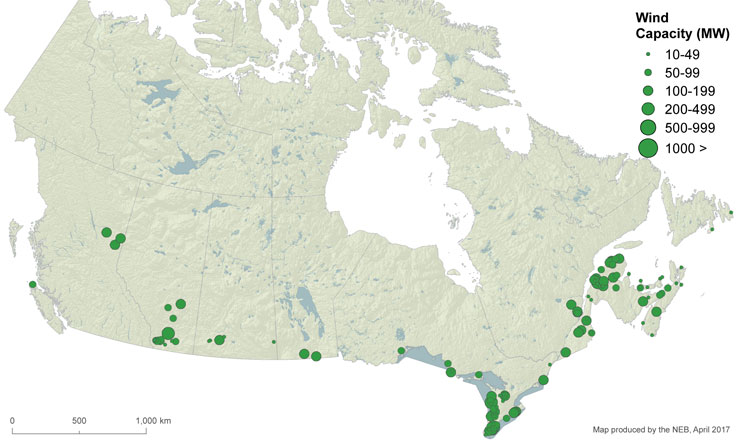
Description:
This map shows the location and approximate capacity of wind power plants with a capacity of at least 10 MW across Canada. Wind farms of this size can be found in every province but not in the territories. Most wind farms are located in Ontario, Quebec, Alberta, B.C. and the Maritime provinces.
International Adoption
Global wind capacity grew by 17.2% in 2015, or a record 63.7 GW, bringing total global wind capacity to 435 GW. China, the second largest wind energy producer in the world, registered the highest increase with 33 GW of new wind capacity installed in 2015.
Three countries, the United States, China, and Germany, produced over 50% of global wind energy in 2015. Canada accounted for 3% of global wind production that year.
Figure 11 – World Wind Electricity Production in 2015
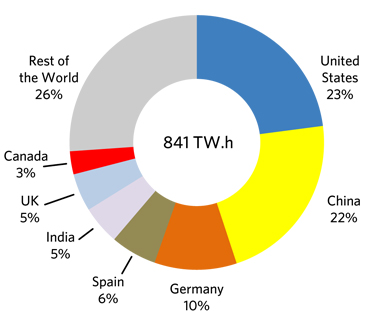
Source: BP World Energy Statistical Review
Description:
The donut chart shows wind generation of top seven producers and the rest of the world. The top seven wind electricity producers are United States, China, Germany, Spain, India, United Kingdom and Canada. Together, they produce almost three quarters of world's electricity from wind. World's total generation of electricity from wind in 2015 was 841 TW.h
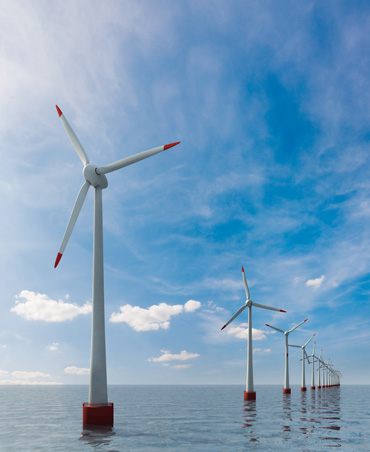
Environmental Considerations
Wind energy is essentially emission-free and wind facilities generate electricity without polluting air or water resources. Wind farms also use as little as 1% of total acreage for turbines and access roads, which means that the remaining land can often still be used for farming or ranching.
Common environmental concerns associated with wind farms include noise and visual disturbance, impacts on birds and bats, and land use concerns. Some GHGs are also produced during the manufacturing, transportation, assembly, and maintenance of wind turbines.
Market Issues
Wind energy is now among the lowest-cost options for new electricity supply in most Canadian provinces. Policymakers and utilities are increasingly recognizing it is a cost-competitive and scalable option for low carbon electricity, but slow electricity demand growth in most provinces means that growth in wind energy will likely depend on a combination of domestic and export growth and specific policies to replace other forms of generation with wind.
Optimal wind sites are often in locations distant from major populations so they require construction of transmission lines to connect to markets. Further, developing a wind farm in a cold climate requires consideration of the impact of ice on its installation, operation, and maintenance. Adaptations include using different materials and lubricants, additional heating for certain components, and adding de-icing technologies to rotor blades.
A major drawback of wind technology is intermittency. In recent years, the Independent Electricity System Operator (IESO) in Ontario adopted a series of initiatives to improve wind dispatch, or the ability of wind plants to modify production at the request of the electricity system operator. Thanks to those initiatives, wind generation facilities in Ontario now help balance the system and prevent nuclear shutdowns during periods of surplus base load generation. Wind dispatch helped avoid 19 of these shutdowns in 2015.
Wind leader – Denmark
In 2015, Denmark generated 50% of its electricity from wind, the highest proportion in the world. This creates substantial intermittency challenges, but Denmark has developed methods for managing this.
Denmark has the capacity to transfer 6.4 GW of power to Norway, Sweden and Germany. This is greater than Danish peak demand of 6 GW. This allows Denmark to sell electricity during times of high wind production, and to import electricity in times of low wind production.
Denmark also devoted significant effort to increasing the operational flexibility of its conventional power plants. Coal plants have been optimized to start quickly and on a short notice, and to vary output over a wide range during the day. In addition, Danish regulations were restructured to reduce the use of fossil fuel plants during periods of high wind generation.
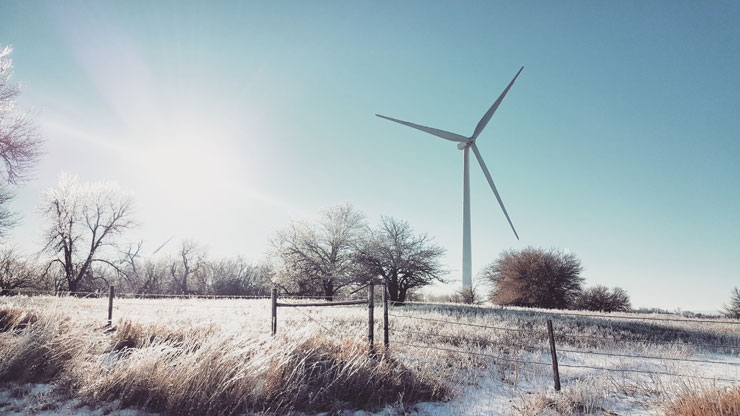
- Date modified:
